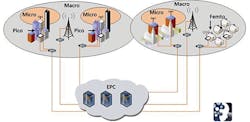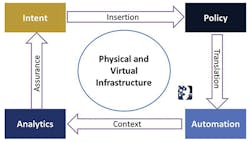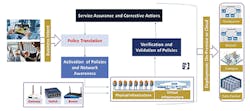Intent Based Networking (IBN) is the concept of business outcome driven network management and operations. IBN system incorporates business intent into enterprise network in an automatic manner, following processes and policies set to achieve desired business outcomes. This includes automatic translation of business policy, activation and replication of policies across entire network, continuous verification and validation of business intent, and assurance of business data, insights, and policy. (See Figure 1.)
Figure 1. Optimizing Radio Access Networks
Terminology often used when discussing IBN includes self-healing, self-driving, self-managed, and self-aware networks. These are also terms associated with another technology that wireless carriers have already been deploying to optimize radio capacity and coverage, Self-organizing Networks (SON). The role of SON is to enable efficient, and in some cases programmatic means of fine-tuning cellular Radio Access Networks (RAN).
SON solutions provide automation solution for planning, configuration, management, optimization, and healing of mobile RAN functions. This self-organizing network can guide next-generation OSS/BSS model for telecom carriers supporting automation of manual steps.
Implementation and operation of SON can fix fundamental problems (i.e., the-tire-is-out-of-alignment analogy), such as poor coverage and/or dropped calls in an area and it can also be used for short-term, real-time issues (and then potentially be put back the way the network was in the first place). Just as SON optimizes cellular network coverage and capacity, the intelligent-based networking market will optimize networks as a whole and not just at the RAN level.
Efforts to improve RAN operation have been ongoing for many years and this is expected to continue, especially as new radio technologies are introduced such as 5G. (For more on 5G Network Optimization see The Role of Smart Antennas in Optimizing 5G). With IBN however, the network as a whole will be positively impacted.
From a system perspective, IBN orchestration technologies and solutions optimize interactions between key functions including analytics, automation, and policy management. Successful IBN management systems will include programmable logic and APIs to correctly and completely capture business intent and translate intentions into policies.
Driven by market-leading vendors such as Cisco, IBN represents a means of autonomously and intelligently supporting critical network functions, but it is driven by business objectives. This includes business intentions and related policy enforcement, while simultaneously gathering valuable data.
As indicated in Figure 2, IBN represents a cyclical process in which data gathered from automatic processes provides the context necessary for analytics to indicate the extent to which business intentions are being met across the entire network. Inclusion of Artificial Intelligence (A.I.) technologies such as machine learning enhances IBN data analytics capabilities, allowing systems to learn from previous interactions, and to provide information and directors towards behaviors that support positive outcomes.
Figure 2. IBN supports Intent, Policy, Automation, and Analytics
IBN helps to solve a key challenge for communications and enterprise network management: How to optimize mutually exclusive goals of network optimization, business effectiveness, and cost reduction. Too often, management must spend substantial funds to optimize networks (for many reasons, such as optimizing customer experience), at the cost of increasing operational expenses. The analogy in software development is Pick two out of three: Quality, Fast, and Cheap. You can have any two, but not all three.
In theory, IBN simultaneously addresses all three challenges through network autonomy, provided in part by machine intelligence, which provides AI-based data analytics and automated decision making. In fact, machine learning algorithms will act as the core driver of intelligent IBN system. Other important technologies in support of IBN include Software Defined Networking (SDN) solutions. SDN and virtualization are transforming network and service architecture thanks to improvements in technologies that offer improved performance, lower costs, improved flexibility and control.
The objective is that networks become more adaptive, flexible, survivable, and with less operating expense with IBN. This enables networks (including customer facing apps and services as well as supply chain management) to become more adaptive, flexible, and survivable. As this happens in an autonomous manner (e.g., with limited human intervention), it is able to achieve these goals while simultaneously reducing operating expenses.
One of the key tenants of intent-based networking is policy-based automation, a concept that is not new, but optimized with IBN by tying together WAN network components. This provides a unification of network asset management that enables several important network benefits including end-point flexibility, transport independence, and highly adaptive application and service delivery that meets business goals for QoS, QoE, and profitability. (See Figure 3.)
Figure 3. Next Generation IBN Operational Support Platform Objectives
Importantly, IBN systems do this in a sustainable and self-optimizing manner, as it enables network monitoring, checking, and adjustments necessary to ensure that positive experiences are replicated throughout the network. The goal is to provide these benefits in a network-agnostic way, for both communications and enterprise systems, and regardless of deployment models such as provide data centers, public clouds, software as a service, and open Internet methods.
Next-generation IBN Operational Support System (OSS) platforms will support automated policy enforcement and dynamic resource allocation in support of desired business outcomes. These next-gen OSS solutions will increasingly incorporate the aforementioned technologies in a highly synergist manner in which they support one another, while optimizing often disparate network operations goals, which in turn support overall corporate business objectives.
Organizations will deploy IBN systems for many reasons including reducing network maintenance costs (likely between 60-70%), improvement of service delivery time and experience, eliminate network downtime, and improve the risk profile for business assurance.
With anticipated benefits this significant, Mind Commerce sees as many as 70% enterprise organizations deploying intent-based networking of some type by 2025. This includes automating network operation via IBN optimized hardware, automation software, and wireless connectivity technologies.
Like this Article?
Subscribe to ISE magazine and start receiving your FREE monthly copy today!
In summary, the intent-based networking market is comprised of some key interrelated technologies, which taken together, provide automated network management and orchestration. This allows business operations and IT congruence with desired share outcomes (such as the state of the network, apps, and services) and successful enforcement of related policies to ensure sustainable optimization.
The Mind Commerce report Intent Based Networking Market: IBN by Technology, Infrastructure (Hardware, Software, Components, and Services), Solutions, Deployment Type, Network (WAN, MAN, LAN, PAN) and Connection (3G, LTE, 5G), Organization Type, and Industry Verticals 2019 – 2024 evaluates intent-based networking including comparison of IBN with traditional networking in terms of architecture, capabilities, and benefits for carrier and enterprise networks.
For more information about the report, visit https://mindcommerce.com/reports/intent-based-networking-market/
About the Author

Gerry Christensen
Gerry Christensen is Principal Consultant with Wireless Waypoint, which provides consulting, management, advisory and expert services for the information and communications technology industry. Core competency areas are switching, signaling, and related technologies and solutions. Practice areas include strategy, business development, fractional and interim management. This includes legacy telecom/IT as well as emerging business models and ecosystems, network infrastructure, VoIP networking and IP based services, operational and business support systems.
For more information, and to connect with him, visit www.linkedin.com/in/gerrychristensen/.



